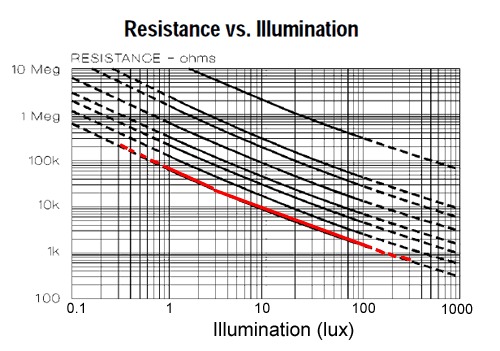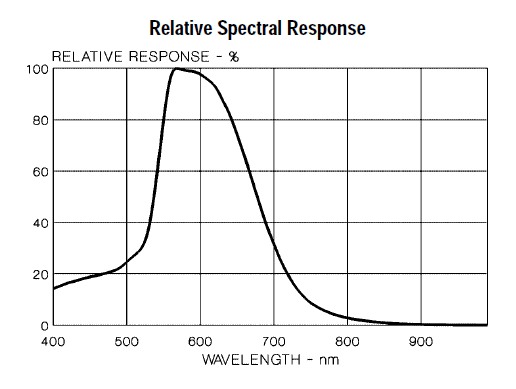Différences entre versions de « Photo-résistance »
| Ligne 41 : | Ligne 41 : | ||
| align="center" width="400" | Example | | align="center" width="400" | Example | ||
|- style="font-size: 90%" | |- style="font-size: 90%" | ||
| − | | align=" | + | | align="left" | 0.002 lux |
| − | | align=" | + | | align="left" | Moonless clear night sky |
|- style="font-size: 90%" | |- style="font-size: 90%" | ||
| − | | align=" | + | | align="left" | 0.2 lux |
| − | | align=" | + | | align="left" | Design minimum for emergency lighting (AS2293). |
|- style="font-size: 90%" | |- style="font-size: 90%" | ||
| − | | align=" | + | | align="left" | 0.27 - 1 lux |
| − | | align=" | + | | align="left" | Full moon on a clear night |
|- style="font-size: 90%" | |- style="font-size: 90%" | ||
| − | | align=" | + | | align="left" | 3.4 lux |
| − | | align=" | + | | align="left" | Dark limit of civil twilight under a clear sky |
|- style="font-size: 90%" | |- style="font-size: 90%" | ||
| − | | align=" | + | | align="left" | 50 lux |
| − | | align=" | + | | align="left" | Family living room |
|- style="font-size: 90%" | |- style="font-size: 90%" | ||
| − | | align=" | + | | align="left" | 80 lux |
| − | | align=" | + | | align="left" | Hallway/toilet |
|- style="font-size: 90%" | |- style="font-size: 90%" | ||
| − | | align=" | + | | align="left" | 100 lux |
| − | | align=" | + | | align="left" | Very dark overcast day |
|- style="font-size: 90%" | |- style="font-size: 90%" | ||
| − | | align=" | + | | align="left" | 300 - 500 lux |
| − | | align=" | + | | align="left" | Sunrise or sunset on a clear day. Well-lit office area. |
|- style="font-size: 90%" | |- style="font-size: 90%" | ||
| − | | align=" | + | | align="left" | 1,000 lux |
| − | | align=" | + | | align="left" | Overcast day; typical TV studio lighting |
|- style="font-size: 90%" | |- style="font-size: 90%" | ||
| − | | align=" | + | | align="left" | 10,000 - 25,000 lux |
| − | | align=" | + | | align="left" | Full daylight (not direct sun) |
|- style="font-size: 90%" | |- style="font-size: 90%" | ||
| − | | align=" | + | | align="left" | 32,000 - 130,000 lux |
| − | | align=" | + | | align="left" | Direct sunlight |
|} | |} | ||
Version du 6 mai 2012 à 21:31
What is a photocell?
Photocells are sensors that allow you to detect light. They are small, inexpensive, low-power, easy to use and don't wear out. For that reason they often appear in toys, gadgets and appliances. Theys are are often referred to as CdS cells (they are made of Cadmium-Sulfide), light-dependent resistors (LDR), and photoresistors.
Photocells are basically a resistor that changes its resistive value (in ohms Ω) depending on how much light is shining onto the squiggly face. They are very low cost, easy to get in many sizes and specifications, but are very innacurate. Each photocell sensor will act a little differently than the other, even if they are from the same batch. The variations can be really large, 50% or higher! For this reason, they shouldn't be used to try to determine precise light levels in lux or millicandela. Instead, you can expect to only be able to determine basic light changes
For most light-sentsitive applications like "is it light or dark out", "is there something in front of the sensor (that would block light)", "is there something interrupting a laser beam" (break-beam sensors), or "which of multiple sensors has the most light hitting it", photocells can be a good choice!
Quelques données techniques
- Resistance range: 200K Ω (dark) to 10KΩ (10 lux brightness)
- Sensitivity range: CdS cells respond to light between 400nm (violet) and 600nm (orange) wavelengths, peaking at about 520nm (green).
- Power supply: pretty much anything up to 100V, uses less than 1mA of current on average (depends on power supply voltage)
Problems you may encounter with multiple sensors...
If, when adding more sensors, you find that the temperature is inconsistant, this indicates that the sensors are interfering with each other when switching the analog reading circuit from one pin to the other. You can fix this by doing two delayed readings and tossing out the first one
See this post for more information
How to measure light using a photocell
As we've said, a photocell's resistance changes as the face is exposed to more light. When its dark, the sensor looks like an large resistor up to 10MΩ, as the light level increases, the resistance goes down. This graph indicates approximately the resistance of the sensor at different light levels. Remember each photocell will be a little different so use this as a guide only!
Note that the graph is not linear, its a log-log graph!
Photocells, particularly the common CdS cells that you're likely to find, are not sensitive to all light. In particular they tend to be sensitive to light between 700nm (red) and 500nm (green) light.
Basically, blue light wont be nearly as effective at triggering the sensor as green/yellow light!
What the heck is lux?
Most datasheets use lux to indicate the resistance at certain light levels. But what is lux ? Its not a method we tend to use to describe brightness so its tough to gauge. Here is a table adapted from a Wikipedia article on the topic!
| Illuminance | Example |
| 0.002 lux | Moonless clear night sky |
| 0.2 lux | Design minimum for emergency lighting (AS2293). |
| 0.27 - 1 lux | Full moon on a clear night |
| 3.4 lux | Dark limit of civil twilight under a clear sky |
| 50 lux | Family living room |
| 80 lux | Hallway/toilet |
| 100 lux | Very dark overcast day |
| 300 - 500 lux | Sunrise or sunset on a clear day. Well-lit office area. |
| 1,000 lux | Overcast day; typical TV studio lighting |
| 10,000 - 25,000 lux | Full daylight (not direct sun) |
| 32,000 - 130,000 lux | Direct sunlight |
Source: cds
Traduit avec l'autorisation d'AdaFruit Industries - Translated with the permission from Adafruit Industries - www.adafruit.com
Toute référence, mention ou extrait de cette traduction doit être explicitement accompagné du texte suivant : « Traduction par MCHobby (www.MCHobby.be) - Vente de kit et composants » avec un lien vers la source (donc cette page) et ce quelque soit le média utilisé.
L'utilisation commercial de la traduction (texte) et/ou réalisation, même partielle, pourrait être soumis à redevance. Dans tous les cas de figures, vous devez également obtenir l'accord du(des) détenteur initial des droits. Celui de MC Hobby s'arrêtant au travail de traduction proprement dit.

